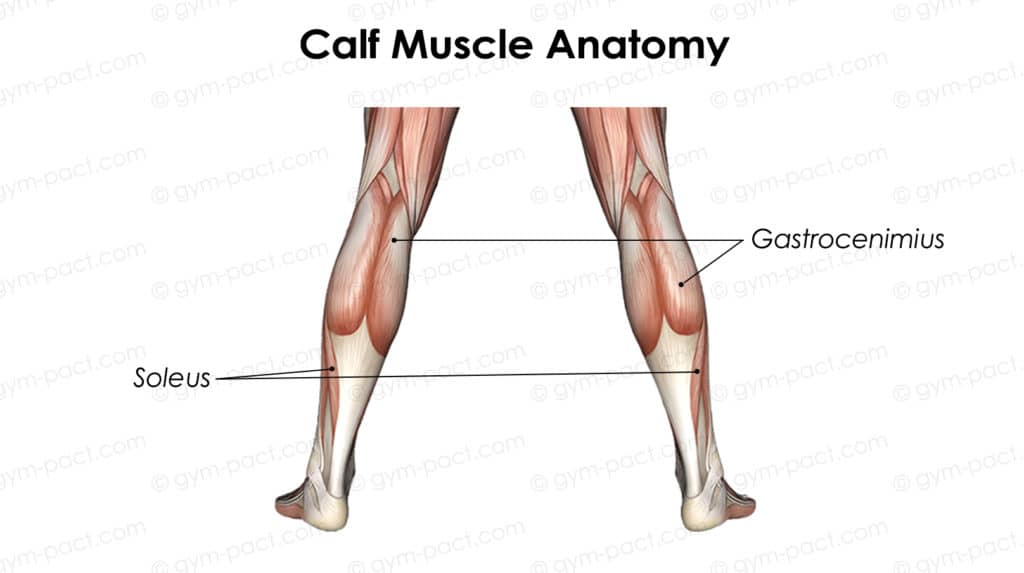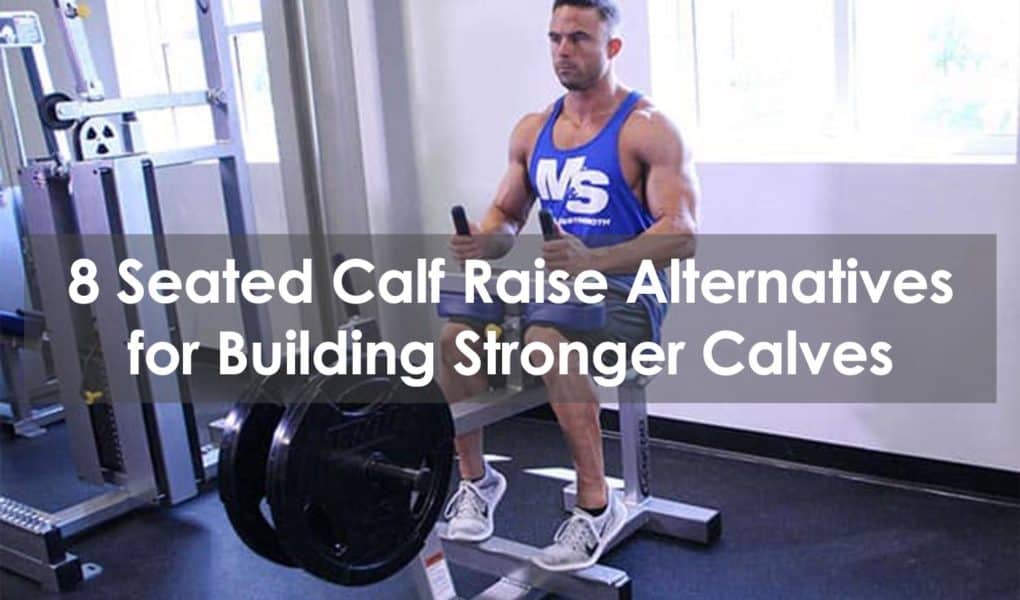The calves are a notoriously difficult muscle to train, but they should be an important part of your leg workout.
A seated calf raise machine is a pretty simple way of making sure you’re giving your calves the workout they need, but not everyone has access to one.
I do most of my training at home, and I definitely don’t have the money (or space) to splash out on a machine, so I need some alternatives.
Your calf is made up of two muscles; the soleus and the gastrocnemius. A seated calf machine trains both these muscles, so your alternatives need to do the same.

If you want to see gains in your calf muscles, here are the 8 best alternatives to seated calf raises.
1. Single-Leg Standing Calf Raises
One of the main benefits of this exercise is how simple it is. All you need is a step; these can be done on the bottom step of your stairs at home.
They also work both muscles in your calf, ensuring you’re covering your bases. You can perform these exercises with just your body weight, or with weights for more of a challenge.
How to:
- Stand on the edge of a step with one foot, the other slightly raised off of it.
- If required, hold onto something to stabilize yourself.
- Lower the heel of your working leg toward the ground, ensuring the non-working leg does not touch the step.
- Drive up onto the tiptoes of your working leg.
- Hold for a second in the top position.
- Do all repetitions on one leg, then switch to the other.
Suggested reps:
12-15 on each leg.
Equipment used:
- None
2. Seated Dumbbell Calf Raises
If you’re looking to replicate the seated calf raise machine as closely as possible, this exercise might just do the trick.
Like on the machine, you’ll be working the entire calf and you’re adding resistance to it with dumbbells, meaning you can really build up strength.
The main way to perform this exercise is to have your feet on the ground, but you can instead stack some weight plates and place your feet on the edge of this stack and perform the exercise for a wider range of movement.
How to:
- Sit on a bench facing away from one of the longer sides with your knees bent and feet flat on the ground.
- Hold a dumbbell end-to-end on each thigh, just above the knee.
- Keeping your toes on the ground, drive both your heels up and hold for one second.
- Slowly lower your heels back to the starting position.
Suggested reps:
10-12.
Equipment used:
- Bench
- Two dumbbells
- Weight plates (optional)
3. Jump Rope
Jumping rope isn’t just an awesome cardio workout; it can also fire up your calves.
As you’re bouncing off the balls of your feet, your calf muscles need to work hard to keep your momentum going and ensure you don’t trip over your jump rope and embarrass yourself.
Plus, as long as you’ve got a jump rope to hand, it can be done pretty much anywhere!
How to:
- Ensure your rope is the right length for you.
- With your feet and knees close together, flick the rope over your head and pass it under your feet by pushing off your toes into a gentle and quick hop.
- Once you’ve gotten the swing of things, try to focus on pushing off the toes of just one foot at a time, alternating with each passing of the rope.
- Ensure your legs don’t lock out – keep your knees soft.
Suggested reps:
40-60 seconds at a time.
Equipment used:
- Jump rope
4. Tip Toe Farmer’s Walk
Sometimes, all you’ve got access to is a set of dumbbells. The good news is that this doesn’t have to get in the way of your calf gains.
The bad news is that you’ll look a bit silly doing this exercise. Fear not though, as you’ll have the last laugh once you’ve got calves of steel.
How to:
- Hold a dumbbell in each hand, down by your sides.
- Push up onto your toes and take controlled steps forward for the allotted time/distance.
- Do not let your heels touch the ground and keep a soft bend in your knees throughout.
Suggested reps:
30 seconds.
Equipment used:
- Dumbbells
5. Box Jumps
Like jump rope, box jumps give you a great cardio workout while also targeting your calves.
When starting out with these, make sure the box you’re using isn’t too tall. Once you’ve been doing these jumps for a while, you can use a taller box or even stack some on top of each other.
How to:
- Stand in front of a box with your feet shoulder-width apart.
- Move your weight into the front of your feet, slightly raising your heels.
- Bend your knees and drive through the front of your feet to jump up onto the box.
- Bend your knees as you land on the box, ensuring you land on your toes.
- Step back off the box and repeat.
Suggested reps:
10-12.
Equipment used:
- Plyo box
6. Single Leg Calf Jumps
Another one that might look a bit silly, but trust me this is a killer exercise for your calves.
You don’t need any equipment, though you can add weight if you feel it’s needed. For beginners, it might be a better idea to perform these as double leg jumps at first, before building to single-leg ones.
How to:
- Stand on one leg with your knee slightly bent.
- Rise onto your toes, then bend your knee more and push off the ground for a controlled jump.
- Land on the same foot and drive straight back into another jump.
- Repeat for time, then switch to the other leg.
Suggested reps:
30 seconds on each leg.
Equipment used:
- None
7. Squat Hold Calf Raises
Due to the position your body is in with this exercise, it’s a great alternative to the seated calf raise machine. It also works your glutes as an added bonus!
How to:
- Stand with your feet shoulder-width apart and your arms out in front (for more resistance you can hold a weight).
- Lower into a squat and hold at the bottom of the position.
- Stay in the squat position and rise up onto your toes before returning your heels to the floor.
Suggested reps:
15-20
Equipment used:
- None
8. Smith Rack Calf Raises
The smith rack allows you to load more weight onto your bar, meaning you can work your calves even harder, making it a great alternative to the seated calf raise.
How to:
- Set the bar at shoulder height.
- Place a small bench or step inside the rack, and stand on it with the front half of your feet.
- Load the bar onto your shoulders and lift it from the rack to take the weight of it.
- Lower your heels toward the floor then push up onto your toes, being sure to never lock out your knees.
Suggested reps:
8-12
Equipment used:
- Smith rack
Conclusion
The seated calf raise is not the be-all and end-all for training your calves. As we’ve shown, there are plenty of suitable alternatives to make sure you’re targeting those tricky muscles at the back of the lower leg.
Give these exercises a go and see which ones work best for you.
Frequently Asked Questions
Are seated or standing calf raises better?
In order to work the entirety of your calf muscle, you should ideally do both. Separately, they both have their benefits and you can’t go wrong either way.
How many times a week should you work calves?
For the best results, aim to train your calves two to three times a week but ensure you leave at least two days of rest between each session on them.
Will calf raises increase calf size?
If done consistently and with the appropriate resistance, then yes! Just be sure to gradually increase the resistance or the number of raises you do overtime.







